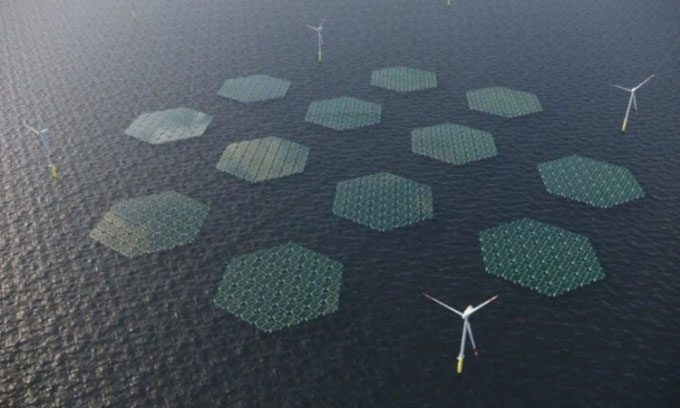Dutch Company Solar Duck Prepares to Build the World’s Largest Floating Solar Power Plant with a Capacity of 5 MW.
The construction process of the 5 megawatt (MW) floating solar power plant is set to begin with design, construction, and facility introduction stages, as reported by Interesting Engineering on March 5. Solar Duck, a Dutch company, is providing the technology for the plant.

Combining wind turbines, solar panels placed on water will help increase clean electricity production. (Photo: SolarDuck).
SolarDuck is embarking on a $9.1 million project to construct the world’s largest offshore floating solar power project (OFS). This project will be integrated, licensed, and located within the OranjeWind wind farm off the western coast of the Netherlands. Before construction begins, a consortium called Nautical SUNRISE will conduct research on the project’s components to ensure reliability, long-term operability, stability, and productivity of the floating plant. Depending on the research results, authorities will draw up a detailed plan to address challenges and promote the commercialization of the project.
Additionally, the consortium will assess the sustainability of the project, considering factors such as environmental impact and full operational cycles. According to Don Hoogendoorn, the technology director at SolarDuck, the project will enable the company to better understand the ecological impacts and safety of the design.
As countries seek to reduce fossil fuel dependence, energy solutions based on wind and solar power are being rapidly deployed. While the declining cost of electricity from these technologies is a positive sign, the low energy conversion rates remain a significant issue. Both wind and solar power plants require large land areas to generate substantial electricity efficiently.
The land area on Earth is limited and used for diverse purposes, from housing and agriculture to industrial zones. Consequently, wind farms have moved offshore to build larger turbines and harness higher wind speeds, thereby producing more clean electricity. Similarly, solar farms also need to transition to water surfaces. Covering canals with solar panels could be a good idea in water-scarce areas. However, rivers and lakes only account for 0.2% of the planet’s surface. Moreover, rivers are used for inland navigation, so installing solar panels could impact current systems.
In contrast, 71% of the planet’s surface is covered by oceans, providing opportunities to establish facilities that harness abundant sunlight. SolarDuck is interested in installing solar farms in an area referred to as the Sun Belt. Regions such as the Caribbean, Japan, South Korea, and even Oman are rich in sunlight but have limited wind. Due to constrained land areas, large-scale energy infrastructure becomes prohibitively expensive in these locations. However, adjacent seas are ideal for establishing offshore floating power plants. This will help many countries reduce dependence on diesel or natural gas and cut carbon emissions.





















































